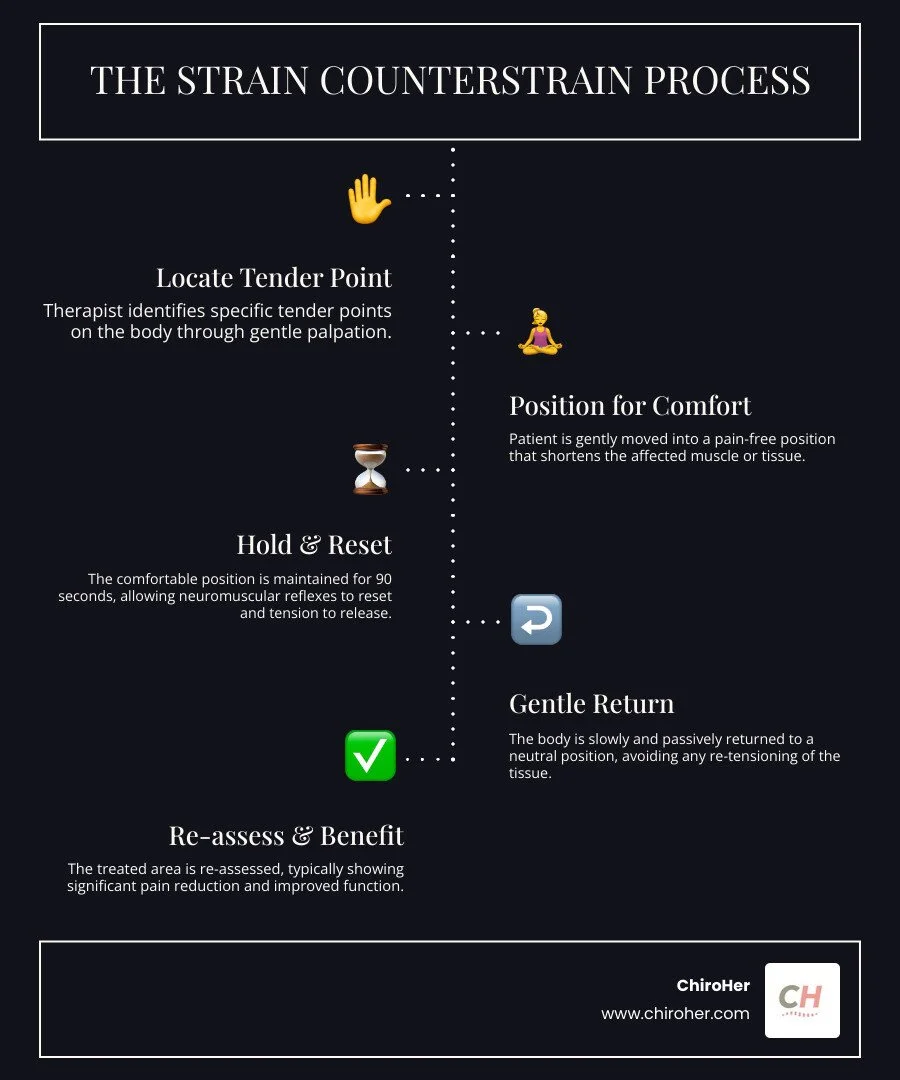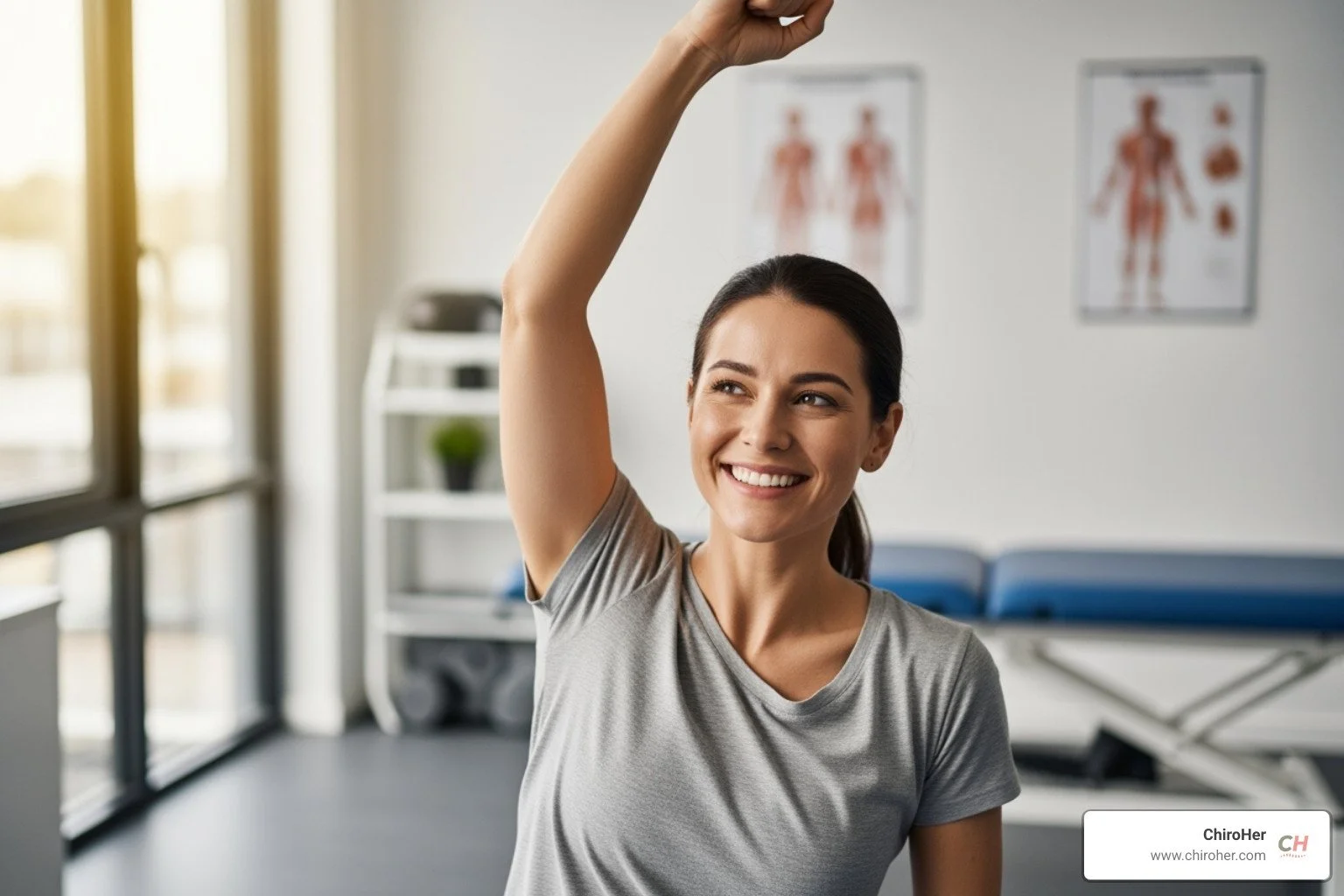How Physical Therapists Utilize Strain Counterstrain for Healing
Understanding Strain Counterstrain in Physical Therapy
Strain counterstrain pt is a gentle manual therapy technique that relieves pain by placing your body into comfortable positions. This process helps reset muscle tension and reduce inflammation.
Key Facts About Strain Counterstrain PT:
Technique: A therapist finds tender points and positions your body to shorten the affected muscle.
Duration: Each position is held for 90 seconds to allow tissues to reset.
Feel: The treatment is gentle, designed to be pain-free, and often described as soothing.
Applications: It treats back pain, neck pain, headaches, fibromyalgia, and many other conditions.
Approach: It addresses root causes in the fascia, nervous system, and circulation, not just symptoms.
Developed in 1955 by osteopathic physician Lawrence Jones, this approach moves your body away from painful positions and into zones of comfort. The technique works by correcting abnormal muscle reflexes that cause spasms and pain. By positioning tissues in a shortened, comfortable state, they can relax and heal naturally.
Hi! I'm Dr. Michelle Andrews, and I've used strain counterstrain pt techniques extensively in my practice to help patients achieve lasting pain relief without aggressive manipulation. My experience with hundreds of athletes and prenatal patients has shown me how effective this gentle approach can be for complex pain patterns.
The Core Principles of Strain Counterstrain PT
At its heart, strain counterstrain pt is a gentle, indirect manual therapy. Instead of aggressive manipulation, it works by identifying specific "tender points" that reflect dysfunctional neuromuscular reflexes.
The technique's proposed mechanism, the Proprioceptive Theory, suggests that SCS resets improper neuromuscular activity. After an injury, a muscle's protective reflex can become overactive, causing persistent contraction and pain. By shortening the muscle into a position of comfort, we can "turn off" this excessive neural activity, allowing the muscle to relax. This gentle process calms the nervous system, reduces muscle tone, improves circulation, and promotes healing. It is a non-traumatic therapy, making it suitable for many patients, including those with acute pain. For a broader understanding of manual therapy, you might explore our guide on What is Manual Therapy in PT.
The Role of Tender Points in Diagnosis
A cornerstone of strain counterstrain pt is identifying tender points. These are small, distinct, and very tender areas in muscles, tendons, or fascia. Unlike "trigger points," they are localized and do not refer pain elsewhere.
With around 200 identified points, a physical therapist uses skilled palpation to locate the ones related to your dysfunction. A tender point often feels like a small, swollen nodule that is sharp when pressed. This diagnostic tool helps us pinpoint the exact source of neuromuscular dysfunction. Research continues to refine our understanding of these points, and you can learn more about the science in resources like A New Rationale for Neuromuscular Tender Points.
The Typical SCS Treatment Process
A strain counterstrain pt session is simple, effective, and designed to be pain-free. Here's what to expect:
Tender Point Identification: We gently palpate your body to locate the specific tender points associated with your pain.
Passive Positioning: Our therapist guides your body into a "position of comfort" that shortens the tissue around the tender point, aiming for at least a 70% reduction in tenderness.
The 90-Second Hold: We hold this comfortable position for about 90 seconds, allowing the neuromuscular reflex to "reset." Patients often find this phase deeply relaxing.
Slow Return to Neutral: The therapist slowly and passively returns the treated area to a neutral position to avoid reactivating the reflex.
Re-assessment: We re-palpate the tender point to confirm a significant decrease in tenderness and check for immediate improvements in your range of motion.
This hands-on process allows tissues to release tension and restore function without discomfort.
How Strain Counterstrain PT Addresses Multiple Body Systems
While traditional strain counterstrain pt focused on muscles and joints, advanced SCS now addresses a wider range of body systems. This approach recognizes that pain often stems from interconnected issues.
Here's how advanced SCS helps beyond just muscles:
Fascia: SCS addresses restrictions in the body's connective tissue web, restoring its elasticity and glide to relieve pain and stiffness. Learn more in our article on Connective Tissue Manipulation.
Lymphatic System: The technique can improve the pumping mechanism of lymphatic vessels, helping to drain fluid, reduce swelling, and decrease inflammation associated with conditions like fibromyalgia.
Nervous System: By targeting fascial restrictions around nerves, SCS can reduce impingement and restore proper nerve signaling, helping with issues like sciatica or carpal tunnel.
Circulatory System: SCS can release fascial constraints around blood vessels, promoting better blood flow and helping with issues like vascular headaches.
Visceral System (Organs): Gentle techniques can address restrictions around internal organs, helping to normalize function and alleviate related symptoms like digestive issues.
Discs: SCS offers techniques to address fascial tension around spinal discs, which can help alleviate pain from conditions like herniated discs.
By treating these interconnected systems, strain counterstrain pt offers a comprehensive approach to healing.
Benefits, Conditions, and Finding a Practitioner
The benefits of strain counterstrain pt are extensive and often immediately noticeable. Our patients frequently report significant improvements in their well-being.
Pain Reduction: By resetting neuromuscular reflexes, SCS can lead to a rapid decrease in pain. Studies show an immediate reduction in palpation pain.
Improved Mobility: As muscles relax and fascial restrictions release, joint stiffness decreases, leading to better flexibility and range of motion.
Reduced Inflammation: SCS promotes better circulation and lymphatic drainage, which helps reduce inflammation and swelling.
Increased Strength: Studies have shown impressive strength gains (e.g., 41-73% in the hip) after SCS treatment, likely due to normalized muscle function.
Gentle and Non-Invasive: Its gentle nature makes it ideal for patients with high pain sensitivity, acute injuries, or osteoporosis.
Long-Term Outcomes: By addressing root causes, SCS aims for lasting improvements and helps reduce the recurrence of pain.
For more insights into rehabilitation approaches, you can visit our general guide on PT Techniques.
What Conditions Can SCS Effectively Treat?
The versatility of strain counterstrain pt allows us to treat a wide array of conditions, from acute injuries to chronic pain. Here are some common examples:
Musculoskeletal Pain: Back and neck pain, shoulder and hip pain, knee and ankle issues, plantar fasciitis, tendinitis, and muscle spasms.
Headaches and Cranial Issues: Tension headaches, migraines, TMJ dysfunction, and some forms of vertigo or balance disorders.
Neurological and Systemic Conditions: Nerve impingements like sciatica or carpal tunnel syndrome, fibromyalgia, chronic fatigue, and arthritis pain.
Specific Patient Populations: It is effective for post-operative pain, and its gentle nature makes it a safe option for infants with torticollis, pregnant women, and elderly patients.
We have seen remarkable improvements in patients who have struggled with chronic pain that hasn't responded to other therapies. Because SCS addresses a wide range of body systems, it often helps with seemingly unrelated symptoms.
Integrating SCS with Other Therapies
At ChiroHer, we believe in a comprehensive approach. While strain counterstrain pt is powerful on its own, we often integrate it with other therapies to improve results and make them more comfortable.
Manual Therapy: SCS can prepare the body for other manual techniques like joint mobilization or myofascial release. Learn about our Manual Therapy services.
Therapeutic Exercise: Once pain is reduced, targeted exercises to strengthen muscles and restore movement become more beneficial.
Spinal Adjustments: For chiropractic patients, SCS can relax surrounding muscles, making adjustments more effective and longer-lasting, as explained in our Complete Guide to Spinal Adjustments.
Other Modalities: We may also use dry needling, electric muscle stimulation, or supportive taping to address all facets of your condition.
Qualifications for a Strain Counterstrain PT Practitioner
To ensure the highest quality of care, strain counterstrain pt should be performed by a trained and qualified physical therapist. Its effectiveness relies on a deep understanding of anatomy, precise palpation skills, and specialized training.
At ChiroHer, our physical therapists have undergone specialized training in Strain Counterstrain. You can trust that you are in expert hands. We serve the greater Oklahoma City area, including Yukon, Edmond, Nichols Hills, Del City, Mustang, and Moore. If you're considering this gentle therapy, we invite you to Book your manual therapy session today and experience the ChiroHer difference.
Building Trust: Authority and Evidence
At ChiroHer, we are committed to transparency about the treatments we provide, including strain counterstrain pt. Strain counterstrain is well-established and is the fourth most commonly used osteopathic manipulative technique, trusted by thousands of healthcare providers.
Research findings are encouraging. Studies consistently show that strain counterstrain pt can significantly reduce pain levels and document immediate reductions in tender point pain. We also see exciting strength improvements, with some studies showing hip strength increases of 41-73% and forearm strength gains of 8-12% after treatment.
While research on range of motion shows mixed results, this is common for manual therapy since every body responds differently. Newer research is now exploring how strain counterstrain affects the fascia, lymphatic system, and nervous system, which aligns with the comprehensive improvements our patients experience.
I'm Dr. Michelle Andrews, and I make it a priority to stay current with the latest research. I regularly review new studies and attend continuing education to ensure you're getting care that's both evidence-based and personalized.
We are always transparent about what the research shows. While we've seen remarkable results with strain counterstrain pt in our clinic, every treatment plan combines the best available research with our clinical expertise and your individual goals. For more information on physical therapy, we encourage you to check out trusted sources like the Mayo Clinic on physical therapy.
This guide is for informational purposes and is not a substitute for already established medical advice from your healthcare provider.




